A comparative study of the cryo-EM structures of Saccharomyces cerevisiae and human anaphase-promoting complex/cyclosome (APC/C)
- PMID: 39401078
- PMCID: PMC11473103
- DOI: 10.7554/eLife.100821
A comparative study of the cryo-EM structures of Saccharomyces cerevisiae and human anaphase-promoting complex/cyclosome (APC/C)
Abstract
The anaphase-promoting complex/cyclosome (APC/C) is a large multi-subunit E3 ubiquitin ligase that controls progression through the cell cycle by orchestrating the timely proteolysis of mitotic cyclins and other cell cycle regulatory proteins. Although structures of multiple human APC/C complexes have been extensively studied over the past decade, the Saccharomyces cerevisiae APC/C has been less extensively investigated. Here, we describe medium resolution structures of three S. cerevisiae APC/C complexes: unphosphorylated apo-APC/C and the ternary APC/CCDH1-substrate complex, and phosphorylated apo-APC/C. Whereas the overall architectures of human and S. cerevisiae APC/C are conserved, as well as the mechanism of CDH1 inhibition by CDK-phosphorylation, specific variations exist, including striking differences in the mechanism of coactivator-mediated stimulation of E2 binding, and the activation of APC/CCDC20 by phosphorylation. In contrast to human APC/C in which coactivator induces a conformational change of the catalytic module APC2:APC11 to allow E2 binding, in S. cerevisiae apo-APC/C the catalytic module is already positioned to bind E2. Furthermore, we find no evidence of a phospho-regulatable auto-inhibitory segment of APC1, that in the unphosphorylated human APC/C, sterically blocks the CDC20C-box binding site of APC8. Thus, although the functions of APC/C are conserved from S. cerevisiae to humans, molecular details relating to their regulatory mechanisms differ.
Keywords: APC/C; S. cerevisiae; cell cycle; chromosomes; gene expression; mitosis; ubiquitination.
© 2024, Vazquez-Fernandez et al.
Conflict of interest statement
EV, JY, ZZ, AA, PE, DB No competing interests declared
Figures


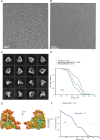
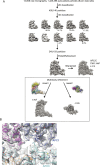
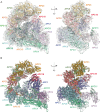




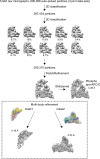



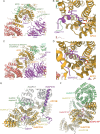



Update of
- doi: 10.1101/2024.06.19.599685
- doi: 10.7554/eLife.100821.1
- doi: 10.7554/eLife.100821.2
Similar articles
-
Molecular mechanism of APC/C activation by mitotic phosphorylation.Nature. 2016 May 12;533(7602):260-264. doi: 10.1038/nature17973. Epub 2016 Apr 27. Nature. 2016. PMID: 27120157 Free PMC article.
-
Atomic structure of the APC/C and its mechanism of protein ubiquitination.Nature. 2015 Jun 25;522(7557):450-454. doi: 10.1038/nature14471. Epub 2015 Jun 15. Nature. 2015. PMID: 26083744 Free PMC article.
-
Substrate binding on the APC/C occurs between the coactivator Cdh1 and the processivity factor Doc1.Nat Struct Mol Biol. 2011 Jan;18(1):6-13. doi: 10.1038/nsmb.1979. Epub 2010 Dec 26. Nat Struct Mol Biol. 2011. PMID: 21186364 Free PMC article.
-
Structure, function and mechanism of the anaphase promoting complex (APC/C).Q Rev Biophys. 2011 May;44(2):153-90. doi: 10.1017/S0033583510000259. Epub 2010 Nov 22. Q Rev Biophys. 2011. PMID: 21092369 Review.
-
Visualizing the complex functions and mechanisms of the anaphase promoting complex/cyclosome (APC/C).Open Biol. 2017 Nov;7(11):170204. doi: 10.1098/rsob.170204. Open Biol. 2017. PMID: 29167309 Free PMC article. Review.
Cited by
-
Phosphate-binding pocket on cyclin B governs CDK substrate phosphorylation and mitotic timing.bioRxiv [Preprint]. 2025 Apr 2:2024.02.28.582599. doi: 10.1101/2024.02.28.582599. bioRxiv. 2025. Update in: Nat Commun. 2025 May 8;16(1):4281. doi: 10.1038/s41467-025-59700-7. PMID: 38464173 Free PMC article. Updated. Preprint.
-
Cryo-EM structures of apo-APC/C and APC/CCDH1:EMI1 complexes provide insights into APC/C regulation.Nat Commun. 2024 Nov 21;15(1):10074. doi: 10.1038/s41467-024-54398-5. Nat Commun. 2024. PMID: 39567505 Free PMC article.
-
Small Molecules Identified by an In Silico Docking Screen Targeting Anaphase-Promoting Complex/Cyclosome Subunit 1 (APC1) Potentiate Paclitaxel-Induced Breast Cancer Cell Death.Molecules. 2025 Feb 14;30(4):895. doi: 10.3390/molecules30040895. Molecules. 2025. PMID: 40005207 Free PMC article.
-
Phosphate-binding pocket on cyclin B governs CDK substrate phosphorylation and mitotic timing.Nat Commun. 2025 May 8;16(1):4281. doi: 10.1038/s41467-025-59700-7. Nat Commun. 2025. PMID: 40341598 Free PMC article.
References
-
- Adams PD, Afonine PV, Bunkóczi G, Chen VB, Davis IW, Echols N, Headd JJ, Hung LW, Kapral GJ, Grosse-Kunstleve RW, McCoy AJ, Moriarty NW, Oeffner R, Read RJ, Richardson DC, Richardson JS, Terwilliger TC, Zwart PH. PHENIX: a comprehensive python-based system for macromolecular structure solution. Acta Crystallographica. Section D, Biological Crystallography. 2010;66:213–221. doi: 10.1107/S0907444909052925. - DOI - PMC - PubMed
Publication types
MeSH terms
Substances
Grants and funding
LinkOut - more resources
Full Text Sources
Miscellaneous

